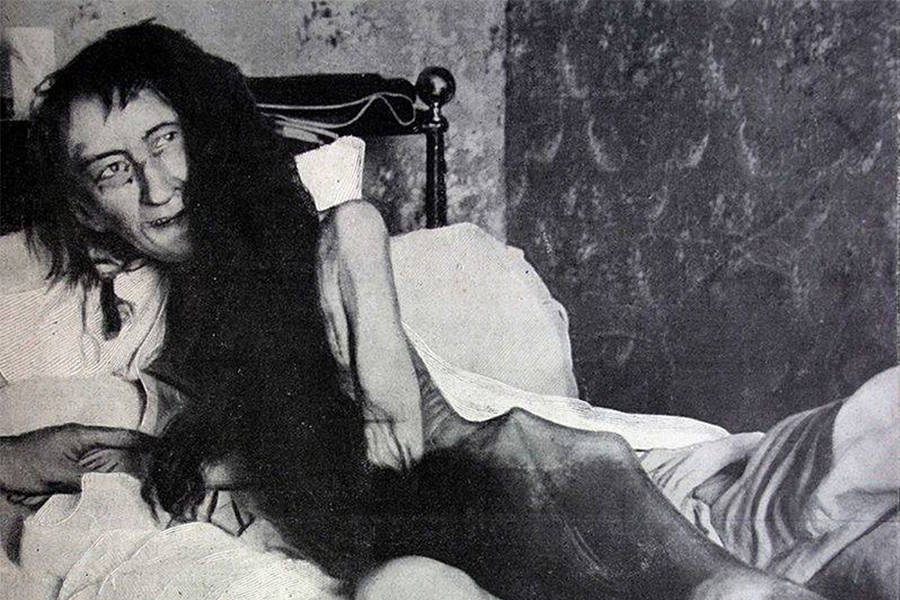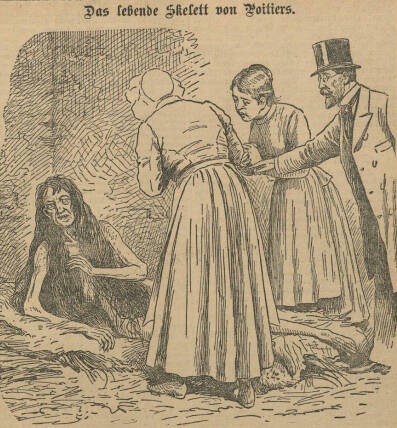Blanche Monnier's prominent French family was dismayed she fell in love with a commoner. So they confined her to a tiny, lightless room for over two decades.
In May 1901, the attorney general of Paris received a strange letter declaring that the prominent Monnier family in the city of Poitiers, France was keeping a disturbing secret. According to the letter, a “spinster” had been held prisoner inside the Monnier household for 25 years, and she was living “in her own filth.” That prisoner was Blanche Monnier.
The unknown author wrote the letter by hand and did not sign it. And up until that point, the Monnier family had had a stellar reputation.
Regardless, the contents of the anonymous letter disturbed the attorney general so much that he decided to investigate the case immediately. What police officers found inside the Monnier family’s house would shock France.
Blanche Monnier — a Monnier family member who was once thought to be overseas — had been hidden inside a padlocked room in the home for a quarter of a century. The once-vibrant socialite was now dangerously underweight, covered in feces, and surrounded by rotting food and bugs. Even worse, she had been imprisoned by her own mother, simply because she had fallen in love with a man that her family didn’t approve of.
The High Status Of The Monnier Family

FacebookA rare image of Blanche Monnier before she was held captive by her own mother.
When the police arrived at the Monnier home, they must have had some misgivings. After all, the aristocratic family was highly respected.
Parisian high society recognized Madame Louise Monnier for her charitable works. According to the Daily Mail, Madame Monnier had even received a community award in recognition of her generous contributions.
Louise Monnier’s late husband had been in charge of a local arts faculty, and the couple’s son Marcel was a law school graduate and worked as an administrative official with the Puget-Théniers commune. The couple also had a daughter named Blanche Monnier, who had been born in 1849.
Often described as “very gentle and good-natured,” the young socialite was widely considered to be physically beautiful, so it’s no surprise that she attracted many suitors as she got older. And considering her family’s prestigious place in society, she was often in the public eye.
However, one day in 1876, Blanche Monnier simply vanished. According to Nine Entertainment, Louise Monnier told people that her daughter had “gone away” or was traveling. As time went on, many of the family’s acquaintances assumed that the young socialite had moved somewhere overseas indefinitely and stopped asking the Monnier family questions about her.
But little did they know that Blanche was being held captive in her own home. And it wasn’t until over two decades had passed that an anonymous letter to the attorney general of Paris would finally reveal her terrible fate:
“Monsieur Attorney General: I have the honor to inform you of an exceptionally serious occurrence. I speak of a spinster who is locked up in Madame Monnier’s house, half starved, and living on a putrid litter for the past twenty-five years — in a word, in her own filth.”
The Discovery Of Blanche Monnier

Wikimedia CommonsBlanche Monnier in her room in 1901, not long after authorities discovered her.
When authorities arrived at the Monnier house in 1901, it was clear that the family did not want them there, especially Louise Monnier. According to The Crime Wire, investigators had to force their way into the home.
At first glance, nothing seemed to be amiss. But upon further investigation, the police noticed a putrid odor coming from upstairs. The smell was the strongest at one door in particular — and that door was padlocked shut. The police broke into the room, unprepared for what lay within.
The room was pitch-black, as its only window had been shuttered and covered with thick curtains. As light streamed in, authorities saw that the horrendous stench was partially due to the rotting scraps of food that littered the floor. But the odor was also coming from a decrepit bed in the room — where an emaciated woman lay. That woman was Blanche Monnier.
When the police officers broke into the room that day and opened the shuttered window, it was the first time Blanche Monnier had seen the sun in over two decades. Her family had kept her imprisoned in the dark room ever since she had “disappeared” as a young, promising socialite in 1876.

YouTubeA French newspaper recounting the tragic story of Blanche Monnier.
Severely malnourished, the now-middle-aged woman weighed only 55 pounds. So weak that she couldn’t even get up to relieve herself, she was forced to lay in her own feces, surrounded by bugs and rotten food.
One officer who was at the crime scene later recalled the horrific sight: “The unfortunate woman was lying completely naked on a rotten straw mattress. All around her was formed a sort of crust made from excrement, fragments of meat, vegetables, fish, and rotten bread. We also saw oyster shells and bugs running across Mademoiselle Monnier’s bed.”
Considering the terrible abuse that the woman had clearly suffered, it was incredible that she was still alive. Indeed, the smell of filth and decay overwhelmed the investigators so much that they were unable to stay in the room for more than a few minutes. It was almost unbelievable to them that she had somehow survived being in that room for about 25 years.
Some officers transported Blanche Monnier to a hospital, while others placed her mother and brother under arrest. Hospital staff reported that although Blanche was terribly malnourished, she was remarkably lucid and even remarked how “lovely” it was to breathe fresh air again.
Slowly, her tragic full story began to emerge.
Why Blanche Monnier Was Imprisoned

Public DomainA 1901 German illustration titled “The Living Skeleton of Poitiers.”
Shortly after her arrest, Madame Louise Monnier admitted that her daughter had found a suitor all those years ago. Much to the disappointment of her family, he was not a young, wealthy aristocrat, but an older lawyer who was broke. Although her mother insisted she choose a more suitable husband, Blanche Monnier refused to abandon the man of her dreams.
In retaliation, Madame Monnier locked her daughter in a padlocked room until she ceded to her will. The years came and went, but Blanche Monnier refused to give in. Even after her beau died in 1885, she was kept locked in her cell, with only vermin for company. Blanche’s brother did not help his sibling — and he was eventually accused of collaborating with his mother.
It was never learned who wrote the letter that triggered Blanche’s rescue. One rumor suggests that a family servant let the secret slip to her boyfriend, who was so horrified that he felt compelled to alert the attorney general.
Regardless, the horrific story soon spread to the public and the outrage was so great that an angry mob formed outside of the Monnier house.

New York Times Archives A 1901 New York Times news clipping reported Blanche Monnier’s story in the United States.
The stress of the public outcry led Madame Monnier to suffer from serious heart problems. She would die 15 days after her daughter’s liberation.
Unfortunately, the only Monnier family member who was alive to answer for the crimes was Blanche’s brother, Marcel. During his trial, Marcel argued that Blanche never wanted to leave her room in the first place and that she chose to stay. At some point, he also claimed that his sister was violent.
Marcel Monnier was sentenced to 15 months in prison for his involvement in his mother’s crimes. However, he was eventually acquitted due to his claims that his sister could have left whenever she wanted to. The fact that a “duty to rescue” law did not exist in the region at the time certainly played a role. And Blanche was in no condition to properly tell her story in court.
Tragically, Blanche Monnier would never live a normal life again following her rescue. Though she showed some improvement over time, the psychological damage proved too extensive for her to return to society. She lived out the rest of her days in a sanitarium in Bois, dying at the age of 64 in 1913.
After reading the horrifying true story of Blanche Monnier, learn about Dolly Oesterreich, who kept her secret lover in her attic. Then, read about Elisabeth Fritzl, who was held captive by her father in her own home.





